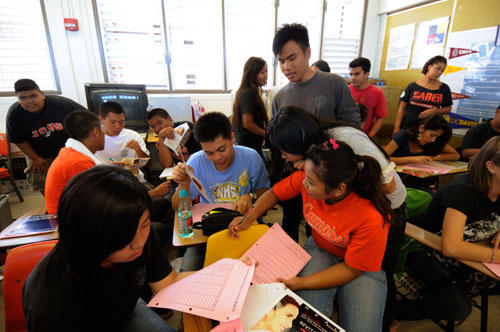$75 million blueprint for change

Randall Roth and Pat Hamamoto have always shared the same goal: The best education for Hawaii’s children.
They’ve just gone about tackling the challenge in different ways.
Roth has been the watchdog, a keen observer and fierce critic of public education in the state. In the early years of Republican Gov. Linda Lingle’s administration, he was a key adviser. Hamamoto, a career public schools teacher and principal and onetime schools superintendent, has served on the front lines.
Now, with Hawaii’s selection as a recipient of a $75 million Race to the Top federal grant, they share the same hope.
Coming off a furlough-shortened school year that left the state’s already-frayed educational reputation in tatters and now facing a shift to more demanding curriculum and tougher graduation standards, word that the government was rewarding the Department of Education for producing "ambitious yet achievable" plans for reform gave both cause for cheer.
Hamamoto now is principal at private Saint Louis School, but she says that even though she doesn’t exactly pine for her days as superintendent – "’Miss’ isn’t the word I’d use,"
Don't miss out on what's happening!
Stay in touch with breaking news, as it happens, conveniently in your email inbox. It's FREE!
she says with a laugh – there’s no way to erase 34 years as a public schools educator.
"I still consider myself part of it," Hamamoto says.

When she learned of the award, she was ecstatic. "It’s awesome," Hamamoto says. "I’m delighted, I’m thrilled … all the adjectives. It just blows me away. I’m so happy for Hawaii education.
"Coming from the point of view of, you know, ‘You don’t have a chance,’ according to the naysayers, this says a lot about the Hawaii school system."
As for Roth, describing him as a fierce critic of public education might be an understatement. In the past, the University of Hawaii law professor has absolutely flayed the system.
In his searing essay "Public Education in Hawaii: Past, Present & Future," Roth paints the DOE as bloated, inflexible, dysfunctional and systemically incapable of governance or accountability.
He still has philosophical differences with government initiatives like Race to the Top and No Child Left Behind, which he sees as top-down solutions to problems that ought to be dealt with from the bottom up. He also remains skeptical of the DOE’s ability to implement reforms.
But he agrees, "This is a terrific boost. It’s great to have success and it’s great to be able to get money at a time when money is tight."
Roth has studied the Hawaii plan and compared it to those put forward by other states and he’s willing to give the DOE its due.
"I’m delighted to see that our plan was not just good, but good in comparison," Roth says. "It’s a verification – not only of the ideas in the plan but the promises in that plan. The fact that the plan could be formulated and submitted and now the public is very much behind it … the people who put the plan together and presented it deserve our congratulations and praise."
State educators say the $75 million, spread over a four-year period, will be used to:
» Institute performance-based contracts for teachers and principals.
» Revive low-performing schools, largely by expanding pre-kindergarten opportunities and extending classroom time.
» Implement the national common core standards curriculum.
» Improve collection and use of student performance data, allowing teachers, parents and schools to quickly see when a student is struggling and track student performance from kindergarten through graduation.
» Streamline how the DOE monitors and supports reforms.
"Despite the furlough days, Hawaii has a real chance to take student achievement to a new level," Secretary of Education Arne Duncan said in a Tuesday conference call announcing the award. "Hawaii absolutely put its best foot forward."
Roth says there was nothing preventing the state from issuing the same proposals in the past but believes that the dedicated funding provided by the grant "magnifies dramatically the chances that the DOE will follow through."
Roth saw promise in the plan’s call for performance assessments and incentives for principals and teachers.
"The thing that’s noteworthy, in my perception, is that it signals that union officials perhaps are recognizing that they need to play a different role than they’ve played in the past if our public education is going to be as good as it can be or needs to be," he says. "In the past they’ve focused on protecting members and maximizing benefits. I think they may be recognizing that their members also want them to factor the kids’ welfare into the equation."
Roth and Hamamoto also believe it’s essential for the DOE to constantly monitor the progress of the plan and measure student growth.
Hamamoto says she has "100 percent faith that everyone involved has the knowledge and the determination to reach the goals in the plan."
But she also knows that in the end only results matter.
Now, Hamamoto says, the message that needs to go out loud and clear is this: "Get the work done."



